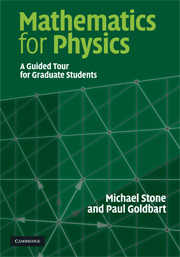Book contents
- Frontmatter
- Contents
- Preface
- Acknowledgments
- 1 Calculus of variations
- 2 Function spaces
- 3 Linear ordinary differential equations
- 4 Linear differential operators
- 5 Green functions
- 6 Partial differential equations
- 7 The mathematics of real waves
- 8 Special functions
- 9 Integral equations
- 10 Vectors and tensors
- 11 Differential calculus on manifolds
- 12 Integration on manifolds
- 13 An introduction to differential topology
- 14 Groups and group representations
- 15 Lie groups
- 16 The geometry of fibre bundles
- 17 Complex analysis
- 18 Applications of complex variables
- 19 Special functions and complex variables
- A Linear algebra review
- B Fourier series and integrals
- References
- Index
11 - Differential calculus on manifolds
Published online by Cambridge University Press: 05 June 2012
- Frontmatter
- Contents
- Preface
- Acknowledgments
- 1 Calculus of variations
- 2 Function spaces
- 3 Linear ordinary differential equations
- 4 Linear differential operators
- 5 Green functions
- 6 Partial differential equations
- 7 The mathematics of real waves
- 8 Special functions
- 9 Integral equations
- 10 Vectors and tensors
- 11 Differential calculus on manifolds
- 12 Integration on manifolds
- 13 An introduction to differential topology
- 14 Groups and group representations
- 15 Lie groups
- 16 The geometry of fibre bundles
- 17 Complex analysis
- 18 Applications of complex variables
- 19 Special functions and complex variables
- A Linear algebra review
- B Fourier series and integrals
- References
- Index
Summary
In this section we will apply what we have learned about vectors and tensors in linear algebra to vector and tensor fields in a general curvilinear coordinate system. Our aim is to introduce the reader to the modern language of advanced calculus, and in particular to the calculus of differential forms on surfaces and manifolds.
Vector and covector fields
Vector fields – electric, magnetic, velocity fields, and so on – appear everywhere in physics. After perhaps struggling with it in introductory courses, we rather take the field concept for granted. There remain subtleties, however. Consider an electric field. It makes sense to add two field vectors at a single point, but there is no physical meaning to the sum of field vectors E(x1) and E(x2) at two distinct points. We should therefore regard all possible electric fields at a single point as living in a vector space, but each different point in space comes with its own field-vector space.
This view seems even more reasonable when we consider velocity vectors describing motion on a curved surface. A velocity vector lives in the tangent space to the surface at each point, and each of these spaces is a differently oriented subspace of the higherdimensional ambient space (see Figure 11.1).
Mathematicians call such a collection of vector spaces – one for each of the points in a surface – a vector bundle over the surface. Thus, the tangent bundle over a surface is the totality of all vector spaces tangent to the surface. Why a bundle? This word is used because the individual tangent spaces are not completely independent, but are tied together in a rather non-obvious way.
- Type
- Chapter
- Information
- Mathematics for PhysicsA Guided Tour for Graduate Students, pp. 376 - 413Publisher: Cambridge University PressPrint publication year: 2009



